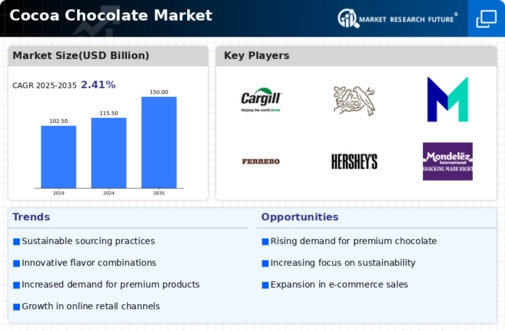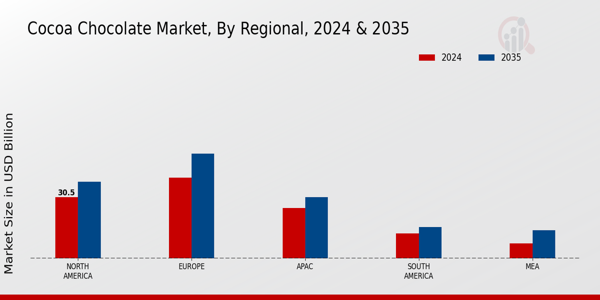Cocoa Chocolate Size
Cocoa Chocolate Market Growth Projections and Opportunities
The cocoa chocolate market is influenced by a myriad of factors that contribute to its growth and market dynamics. One primary determinant is the global cocoa production, which is susceptible to weather conditions, disease outbreaks, and geopolitical factors. The geographical locations where cocoa is predominantly grown, such as West Africa, South America, and Southeast Asia, play a crucial role in determining the overall supply of cocoa for chocolate production. Fluctuations in cocoa production can impact the prices of cocoa beans, subsequently affecting the cost of chocolate production.
Economic factors significantly influence the cocoa chocolate market. As disposable incomes rise, consumers tend to indulge in premium and high-quality chocolate products. Conversely, during economic downturns, there may be a shift towards more affordable and mass-market chocolate options. The pricing of cocoa chocolate is closely tied to cocoa bean prices, production costs, and the brand positioning within the market.
Consumer preferences and changing dietary trends play a pivotal role in shaping the cocoa chocolate market. There is a growing demand for specialty chocolates, including dark chocolate, organic chocolate, and chocolates with unique flavor profiles. Health-conscious consumers also drive the market towards products with higher cocoa content, as dark chocolate is perceived to have potential health benefits. Producers in the cocoa chocolate market respond to these trends by innovating their product offerings and adapting to evolving consumer preferences.
Government regulations and ethical considerations are crucial market factors for the cocoa chocolate industry. The chocolate industry has faced scrutiny regarding ethical sourcing, child labor, and fair trade practices in cocoa-producing regions. Regulatory standards, certifications such as Fair Trade and Rainforest Alliance, and commitments to sustainable and ethical sourcing practices are increasingly important for chocolate producers. Compliance with these standards is essential not only for meeting consumer expectations but also for maintaining a positive brand image.
Supply chain considerations are paramount in the cocoa chocolate market. The journey from cocoa bean to the final chocolate product involves various stages, including harvesting, fermentation, drying, processing, and manufacturing. Ensuring a stable and transparent supply chain is essential for maintaining product quality, meeting demand, and addressing concerns related to ethical sourcing. Producers often invest in initiatives to trace the origin of cocoa beans and promote sustainable and responsible sourcing practices.
Competition within the cocoa chocolate market is intense, with both established brands and artisanal chocolatiers vying for consumer attention. Branding, product innovation, and marketing strategies become critical elements in a market where consumers are influenced by taste, packaging, and the perceived quality of chocolate. Producers focus on creating unique selling propositions, whether through the use of premium ingredients, distinctive flavor profiles, or sustainable sourcing practices.
Environmental sustainability is an increasingly important consideration in the cocoa chocolate market. With growing awareness of deforestation, climate change, and environmental impact, consumers are seeking products with eco-friendly practices. Sustainable sourcing of cocoa beans, eco-friendly packaging, and commitments to reducing the carbon footprint are key initiatives embraced by responsible chocolate producers.











Leave a Comment